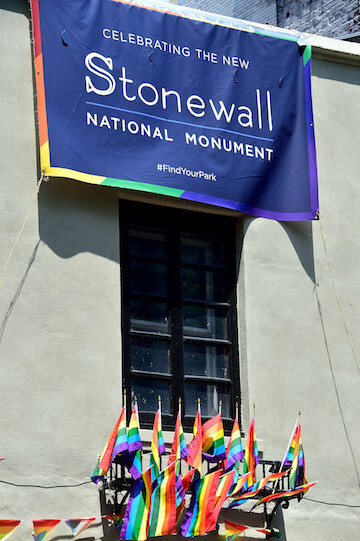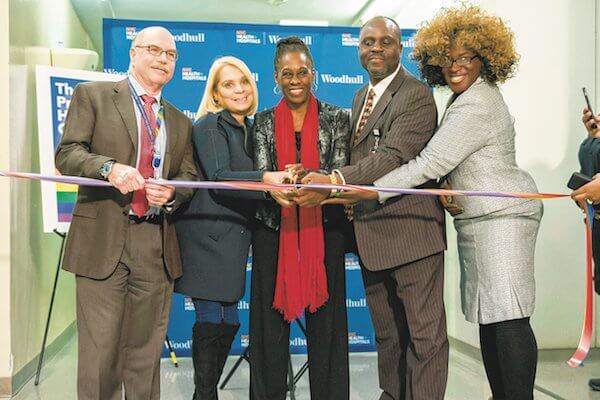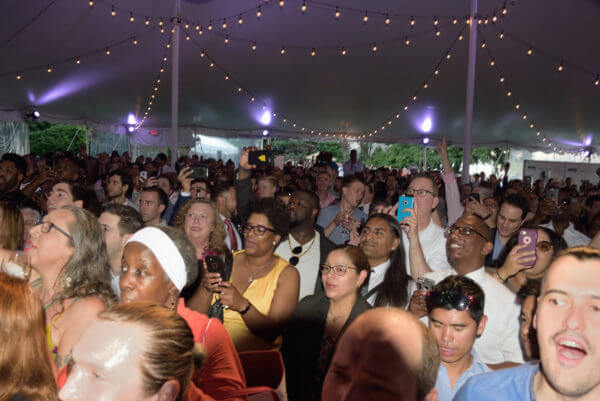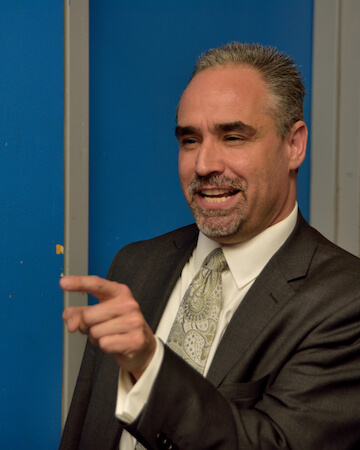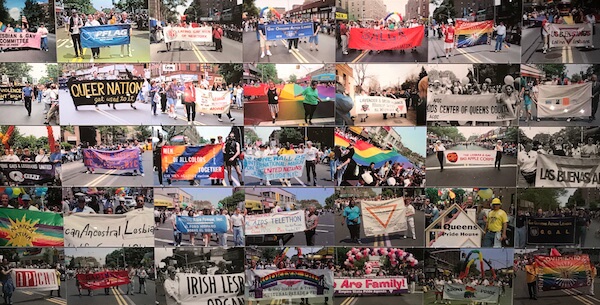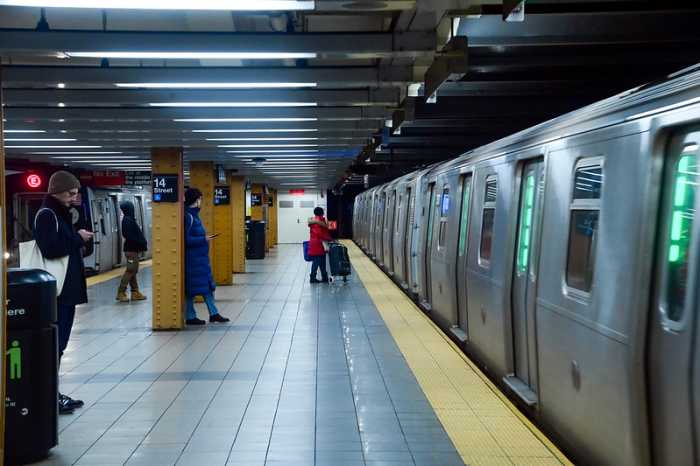Officials and activists at the Stonewall National Monument dedication included US Representative Carolyn Maloney, successful DOMA plaintiff Edie Windsor, New York City First Lady Chirlane McCray, Mayor Bill de Blasio, Representative Jerrold Nadler, City Councilmember Corey Johnson, Interior Secretary Sally Jewell, National Park Service director Jonathan Jarvis, White House senior advisor Valerie Jarrett, State Senator Brad Hoylman, and Assemblymember Deborah Glick. | DONNA ACETO
While not quite as deep as the Grand Canyon or as tall as the Statue of Liberty, the 7.7 acres in and around the Stonewall Inn, scene of the monumental 1969 multi-night rebellion in the streets that sparked the modern LGBT movement, were declared, like those iconic parks, an official national monument by President Barack Obama on June 24. Three days later, in the light of day on June 27, the area was dedicated as such by federal and local officials and LGBT activists, including a handful who participated in the rebellion.
Tommy Lanigan-Schmidt. | DONNA ACETO
This recognition of an uprising by LGBT outcasts, who were officially criminal, sinful, mentally ill, and almost wholly closeted before that June 28, 1969 night, was an all-American inclusive affair steeped in patriotism. A soulful version of the national anthem was sung by actor Anthony Wayne. Edie Windsor, 88, who won federal recognition of same-sex marriage in 2013 at the US Supreme Court, led a recitation of the Pledge of Allegiance — leaving out the words “under God,” which is the way she grew up saying it before Congress inserted the deity in 1954 at the behest of the Knights of Columbus. Windsor and her partner and later wife Thea Spyer returned to New York from a vacation the second night of the rebellion and soon became activists themselves.
The crowd heard from Obama senior adviser Valerie Jarrett, Secretary of the Interior Sally Jewell, National Park Service director Jonathan Jarvis, US Senator Kirsten Gillibrand of New York and out lesbian Senator Tammy Baldwin of Wisconsin, West Side Congressmember Jerrold Nadler, who is credited with quarterbacking the designation locally, and Mayor Bill de Blasio. The Village’s out elected local officials –– State Senator Brad Hoylman, Assemblymember Deborah Glick, and City Councilmember Corey Johnson also delivered remarks.
Obama makes the scene of 1969 uprising a national monument
White House senior advisor Valerie Jarrett. | DONNA ACETO
The keynote speech was delivered by Tommy Lanigan-Schmidt, who was an 18-year-old participant in the rebellion and is now a prominent artist, who painted a vivid verbal picture of the Stonewall in 1969 — “a dingy non-descript building that was like a speakeasy, run by the Mafia.” When the police hit the bar with a routine raid that night, “we didn’t fight back because we loved the management of Stonewall,” he said, “but because we were humanized in there,” the one bar where slow dancing — “a full embrace” — was allowed.
There was much praise for the administration and local government officials who worked with the near unanimous support of both the LGBT and Village communities to get the national monument designation in place, mainly through the city’s transfer to the federal government of little Christopher Park, across the street from the bar.
Secretary Jewell said, “It takes a village to make a national park.” She also said, “We want our history to be known and to reflect who we are — the diversity of our people.”
Transgender activist Octavia Lewis. | DONNA ACETO
Acknowledging the atrocity in Orlando’s Pulse nightclub that was fresh in everyone’s minds, transgender activist Octavia Lewis said, “We have not come far enough. I want this to be a place where I can bring my children and not be fearful.”
“We want to tell the American LGBT story to the world,” said Gillibrand, who will continue to work with her congressional colleagues to make it “a national park, not just a monument,” though monuments designated by the president, like parks, are run by the National Park Service.
Tribute was paid to the history of activism that led up to the rebellion by Obama advisor Jarrett, who cited Del Martin and Phyllis Lyon of the early lesbian group Daughters of Bilitis, Harry Hay of the Mattachine Society, Frank Kameny and Barbara Gittings who led a gay and lesbian demonstration each Fourth of July in Philadelphia from 1965 through 1969, Stephen Donaldson, the bisexual activist who formed the Student Homophile League at Columbia University in 1966, and the transgender patrons of San Francisco’s Compton’s Cafeteria who rioted over mistreatment, also in 1966. Jarrett also ticked off the achievements of the Obama administration on LGBT rights, from getting rid of Don’t Ask, Don’t Tell to its current efforts to protect transgender rights.
State Senator Brad Hoylman, flanked by Assemblymember Deborah Glick and City Councilmember Corey Johnson. | DONNA ACETO
Hoylman called Obama “our first gay president.”
De Blasio said, “We are not going to sanitize our history, we are going to remember the struggle.”
The Stonewall, after all, was a direct rebellion against oppression by the NYPD.
Two mini acts of rebellion took place at the ceremony. Ken Kidd and Ann Northrop of Queer Nation unfurled a big Gilbert Baker rainbow banner reading “Equal in Every Way” behind the speaker’s platform, and none of the many government security or NYPD personnel on hand tried to remove them.
Veteran gay activist Jim Fouratt, a rebellion participant, walked out on the ceremony, writing in an email later that while he supported the monument designation of the streets where the rebellion unfolded, the Stonewall Inn itself “was a symbol of our oppression not our liberation.” He objected to the fact that no “reference was made to how the following three nights were organized in part by a small group of political gay men including myself, disillusioned members of the Mattachine youth component, and gay anti-war activists and lesbians kicked out of the Women's Liberation Movement.”
Fouratt also objected to the “erasure of the Gay Liberation Front birthed in the third night of the Stonewall Rebellion.”
Congressmember Jerrold Nadler. | DONNA ACETO
Indeed, the historical significance of Stonewall was that it led to immediate and ongoing militant organizing in the community. Historian David Carter, author of a book on Stonewall, said after the ceremony that there were around 30 gay groups at the time of the rebellion and 1,500 just two years later nationwide.
Transgender activist Stefanie Rivera, 37, talked afterwards about the continued peril “of going out and not knowing whether you will make it back” and the challenge of finding employment.
“This should have happened years ago,” said her friend, Elizabeth Rivera.
Veteran gay activist Steve Ashkinazy, a founder of the Harvey Milk High School, said he went to the Stonewall at 16 “because they didn’t card us.” He said of the ceremony: “I am emotionally moved and thankful every time I see progress and change.”
The monument is heralded on a banner hung onto the wall of the Stonewall Inn. | DONNA ACETO

